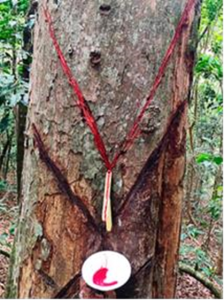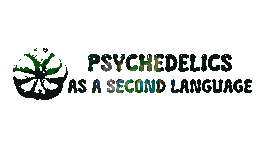Colombian bird bone snuffing tubes and culinary psychedelics
The Indigenous tribes brought us various historical and cultural ornaments, many yet to be found, in between them, various paraphernalia, small statues, and paintings regarding several substances, plenty of them regarding snuffs. Presently, archeologists find pipes and snuff pouches containing mixtures of plants that allow us to dive deeper into their stories and beliefs.

Virola is one of many examples, firstly described by Aublet in “Histoire des plantes de la Guiane Françoise” and later described in 1909 by the German anthropologist Koch-Grünberg that described the use of a snuff prepared from a tree-bark in Yekwana tribes in Rio Orinoco, however, this statement was only defined in 1938 by the Brazilian Botanist Ducke author of “Indians of the upper Rio Negro use the dried leaves of this species [ Virola theiodora] and V. cuspidata in making a snuff powder which they call paricá “.
This snuff was considered magical, and could only be consumed exclusively by the witchdoctor, Shaman, and was named hakúdufha amongst the tribesman, this snuff is prepared from the Virola bark, pounded up, boiled in a small earthenware pot, once the water has evaporated the sediment is toasted over a slight fire and then crushed with a knife making a fine powder which is blown to one’s nose with an apparatus, often monkey and bird-bones as they are hollow and easy to obtain.
The biggest evidence of the consumption of the snuff and perhaps the most intensive users are the members of the tribe Waikás, the tribe belongs to the Orinoco in Venezuela to the North of Río Negro, unlike other tribes the Waikás used the plant in their leisure as well as for the ceremonial purposes, the use of the plant wasn’t solemnly for the Shaman, Curandero, but all of the male members of the tribe.
Unlike the traditional preparation, the Waikás prepared their snuffs in batch for their common usage, therefore, various scrapings of the inner layer of the bark were collected, roasted over the fire, and then crushed with a mortar until the preparation was a fine powder adding a pestle of Bertholettia excelsa fruit, aromatizing the snuff would be the next step of the process, the weedy plant Justicia pectoralis var. stenophylla was often used, a third ingredient is yet to be used, the leguminous tree Elizabetha princeps, named as amá or amasita by the Waikás.
The traditional, ceremonial preparation of the snuff starts with the bark stripped from Virola Theiodora, the bark get gently heated causing a “bleeding” of resin which is then collected and boiled down to a thick consistency, which is crystallized upon cooling, making it an amber red resin, this resin is then ground up to a fine powder and taken alone, however, the use of the plant as an arrow poison is still unsolved.

The ceremonies take place annually, as a memorial to the ones who’ve died in the previous year. Endocannibalism also takes an important role in the ritual, the ashes and calcinated of the dead members are mixed into a fermented banana drink and swallowed with a beverage, afterwards, the elders of the tribe blow enormous amounts of snuff through bird bones or long wooden tubes into each other’s nostrils, resulting in various antique chants, shouting ceremonies, dances, running wildly, and being pounded in the chest repeatedly with fists, clubs, and rocks by a companion as retribution for the grievances. However, the effects of the snuff are so strong that the tribesmen don’t flinch or show signs of pain.
At the end of the ritual, the tribesmen end up succumbing to the drug and lose consciousness, a common occurrence in the main psychoactive compound present in the snuff, 5-MeO-DMT, and the same tryptamine present in Bufo Alvarius venom and the Amazonian snuff made from Anadenanthera Peregrina. Just like the famous Ayahuasca brew, the snuff contains βcarbolines, that act as monoamine oxidase inhibitors (MAOI) making it possible for the tryptamines to take effect orally, the reason why the snuff is active via insufflation.

From the same family as Virola yet in a different context of usage, nutmeg is a culinary delicacy used worldwide in several dishes and desserts, has been used for its psychoactive properties for its easy obtainability and wide range, gaining popularity amongst teenagers as a friendly challenge, pure curiosity and lack of dosage awareness this compound has been responsible for several hospitalizations over the years with side effects such as tachycardia, nausea, agitation, vomiting and hallucinations, since then nutmeg has been banned in Saudi Arabia.
The compound responsible for these events is myristicin, firstly thought to be the psychoactive compound in Virola, a chemical with a structure similar to Mescaline and Amphetamine, considerably a metabolite of MMDA, just like Nutmeg vegetables like carrots, parsley have low quantities of myristicin, and spices such as saffron, fennel, dill, cinnamon, and anise have chemically similar components.


While in-store Nutmeg is displayed in a glass vial, with a saffron color, the seed comes from the plant Myristica fragrans, a tall evergreen tree indigenous to the Moluccas Islands of Indonesia and was traditionally used to treat infectious diseases such as parasites or plagues and tumors as well as some reports regarding the dermatological value on treatment of rashes and infections. This spice was firstly traded in Europe in the middle ages where it gained it’s mythological reputation due to the unusual effects of the seed, strong enough to fight the Black Plague, bring on menstruation with its stimulating effect and poisonous enough to induce abortion, Nutmeg’s mythology eventually made its path to prison culture, described in “The Autobiography of Malcom X”, the author describes purchasing the spice from other inmates concealed in matchboxes, and consuming it mixing it with water.

Regarding its bad connotation in several countries, Nutmeg is widely commercialized and used yearly by millions of people as a spice including for the famous Christmas Eggnog making a point in Paracelsus quote “The dose makes the poison”.
References:
An Ethnobotanical of Four Tribes of Comparison Amazonian lndians by GHILLEAN T. PRANCE B A. Krukoff Curator of Amazonian Botany, Thc N. Y. Botanical Gardcn
A Warning on Nutmeg by Deborah Blum
The plant kingdom and hallucinogens by Richard Evans Schultes
A taxonomic synopsis of Virola (Myristicaceae) in Mesoamerica, including six new species by Daniel Santamaría-Aguilar, Reinaldo Aguilar, Laura P. Lagomarsino
A golden guide to Hallucinogenic Plants by Richard Evans Schultes
